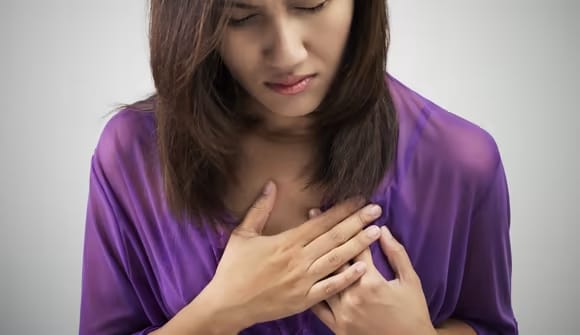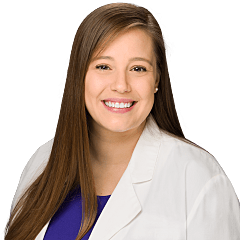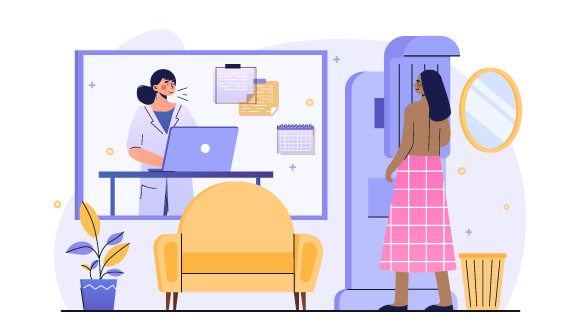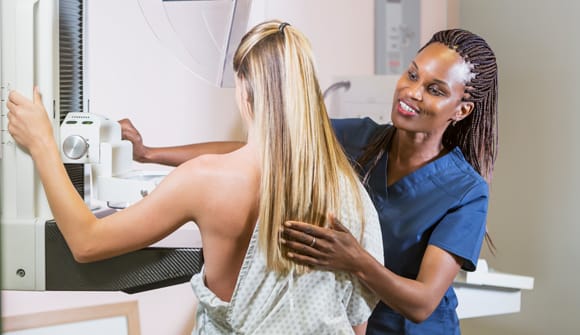Ouch, what is that?
Possible causes of sharp, sudden pain in your breast.
Article Date:

You're cruising along in your day, enjoying the sunshine, and suddenly, out of nowhere, you feel a sharp, stabbing pain in your breast.
First thought: ouch! Next thoughts: heart attack? Breast cancer? What is that?
Hannah Alvarado, DO, family physician with Baptist Primary Care, said, "Breast pain, including sharp shooting pain, is very common and a majority of women will experience it at some point in their lives."
Sharp breast pain types
Dr. Alvarado separated possible causes of breast pain into the following three categories:
Cyclical breast pain
Cyclical pain varies throughout the menstrual cycle with hormonal fluctuations in the body, which can be triggered naturally or with certain medications. This breast pain typically develops around a week before a period and can last throughout the course of your menstrual cycle. People using birth control can also experience these symptoms.
Non-cyclical breast pain
Non-cyclical pain in the breast/chest area is sporadic, intermittent pain that comes and goes. This could be caused by fat necrosis, a benign condition that most commonly results from a past injury or from previous surgery in the area. In addition, Dr. Alvarado explained, "Dietary and lifestyle factors may play a role in breast pain. Consuming a low-fat diet, eliminating smoking, and decreasing caffeine intake can also help alleviate the discomfort."
Extramammary pain
Extramammary pain feels like it is in or around the breast, but may actually originate from other lung or muscle-skeletal issues. There are four common examples of this type of pain:
Stretched ligaments: Females with large breasts may experience pain due to stretching of Cooper's ligaments (the connective tissues that help give breasts their shape). They may also have associated neck, back and shoulder pain.
Costochondritis: Inflammation in the cartilage where the rib and breastbone connect. This pain can be localized to the half of the chest closest to breastbone, and may feel tender when pressure is applied, the rib cage moves, or a person takes a deep breath. It can often occur after heavy lifting or activities that stretch the upper body.
Mastitis: This is inflammation of breast tissue sometimes accompanied by infection, causing pain, red skin patches, swelling and tenderness. It's more common in lactating mothers but can also occur in non-lactating women.
Pleurisy: The two large, thin tissues that separate the lungs from the chest wall (pleura) swell and become inflamed, causing them to rub against each other. This causes pain as you inhale and exhale.
Just glitches
In most cases, these quick stabs of pain are just "glitches" that come and go, lasting only one or two breaths. If the pain is ongoing or becomes more frequent, it's worth a call to your primary care physician (PCP). Be prepared to tell him or her:
- When the pain began
- How long it lasted
- How it felt
- What, if any, other symptoms you had
- How often symptoms occur
In addition to discussing your experiences, your doctor may listen to your heart and lungs, and check your blood pressure and pulse. If your physician thinks your heart may be the problem, he or she may order more testing.
Breast cancer concerns
For many, the first thought that comes to mind when one of these pains occurs is, "Do I have breast cancer?" Fortunately, pain isn't a common indication of breast cancer. However, if it's accompanied by other symptoms, you should contact your primary care physician to get it checked out.
Common symptoms of breast cancer include:
- Lumps or bumps in the breast or surrounding lymph nodes
- Inflammation of the breast, armpits or collarbone
- Changes in nipple appearance or structure, such as nipples that have turned inward
- Skin dimpling or thickening, possibly resembling an orange peel
- Nipple discharge
- Breast or nipple redness, flaking, thickening or dryness
Doctors recommend doing monthly self-exams and getting routine mammograms to help catch potential cancer early.
Trusted treatments for breast pain
"The most common first-line treatment for breast pain is conservative and includes physical support, over-the-counter pain relievers such as ibuprofen or acetaminophen, and manipulation of hormone-based medications for those who take them," said Dr. Alvarado. "But if the pain becomes more frequent, is ongoing, or is accompanied by other symptoms, call your doctor. If the pain is accompanied by lightheadedness, nausea, severe headache or difficulty breathing, call 911."
Have questions about pain you're experiencing? Baptist Primary Care physicians are ready to help. Call 904.202.4YOU or click here to find the right physician for you.




